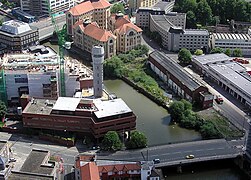
The Clifton Suspension Bridge is a suspension bridge spanning the Avon Gorge and the River Avon, linking Clifton in Bristol to Leigh Woods in North Somerset. Since opening in 1864, it has been a toll bridge, the income from which provides funds for its maintenance. The bridge is built to a design by William Henry Barlow and John Hawkshaw, based on an earlier design by Isambard Kingdom Brunel. It is a Grade I listed building and forms part of the B3129 road.

Clifton College is a public school in the city of Bristol in South West England, founded in 1862. In its early years it was notable for emphasising science rather than classics in the curriculum, and for being less concerned with social elitism, e.g. by admitting day-boys on equal terms and providing a dedicated boarding house for Jewish boys, called Polack's House. Having linked its General Studies classes with Badminton School, it admitted girls to every year group in 1987 and was the first of the traditional, boys, public schools to become fully coeducational. Polack's House closed in 2005 but a scholarship fund open to Jewish candidates still exists. Clifton College is one of the original 26 English public schools as defined by the Public Schools Yearbook of 1889.

Bristol Old Vic is a British theatre company based at the Theatre Royal, Bristol. The present company was established in 1946 as an offshoot of the Old Vic in London. It is associated with the Bristol Old Vic Theatre School, which became a financially independent organisation in the 1990s. Bristol Old Vic runs a Young Company for those aged 7–25.

Wraxall is a village in North Somerset, England, about 6 miles (10 km) west of Bristol. Until 1811 the parish of the same name also included Nailsea and Flax Bourton. The village is now within the parish of Wraxall and Failand.
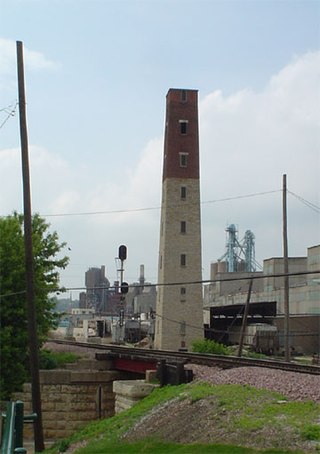
A shot tower is a tower designed for the production of small-diameter shot balls by free fall of molten lead, which is then caught in a water basin. The shot is primarily used for projectiles in shotguns, and for ballast, radiation shielding, and other applications for which small lead balls are useful.

Bristol, the largest city in South West England, has an eclectic combination of architectural styles, ranging from the medieval to 20th century brutalism and beyond. During the mid-19th century, Bristol Byzantine, an architectural style unique to the city, was developed, and several examples have survived.

Goldney Hall is a self-catered hall of residence in the University of Bristol. It is one of three in the Clifton area of Bristol, England.
Redcliffe, also known as Redcliff, is a district of the English port city of Bristol, adjoining the city centre to the northwest. It is bounded by the loop of the Floating Harbour to the west, north and east, together with the New Cut of the River Avon to the south. Most of Redcliffe lies within the city ward of Lawrence Hill, although the westernmost section, including the cliffs and hill from which the area takes its name, is in Cabot ward. Bristol Temple Meads station is located in Redcliffe.

Eley Limited is a British manufacturer of firearms cartridges. Historically the company has produced a broad variety of ammunition, but today specialises in .22 Long Rifle cartridges for competitive target shooting. At the 2020 Tokyo Olympics, six of the twelve medals for cartridge rifle and pistol were won using Eley ammunition.

Birnbeck Pier, also known as the 'Old Pier', is a pier situated on the Bristol Channel in Weston-super-Mare, North Somerset, England, approximately 18 miles (29 km) south-west of Bristol. It is the only pier in the country which links the mainland to an island, linking to Birnbeck Island, a 1.2 hectares rocky island just to the west of Worlebury Hill. The grade II* listed pier was designed by Eugenius Birch and opened in 1867. Birnbeck Pier is one of only six Grade II* piers surviving in the country. The refreshment and waiting rooms of 1898 were designed by local architect Hans Price and the clocktower and the piermaster's house have been attributed to him. The pier has been closed to the public since 1994 and is now on the Buildings at Risk Register.
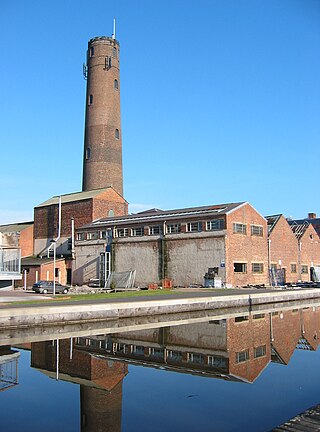
Chester Shot Tower, also known as Boughton Shot Tower, is a grade-II*-listed shot tower located at SJ413667 in the Boughton district of Chester, England. The tower stands beside the Shropshire Union Canal and forms part of the disused Chester Leadworks. Built by Walkers, Parker & Co. in 1799, the tower is the oldest of three remaining shot towers in the UK, and probably the oldest such structure still standing in the world.
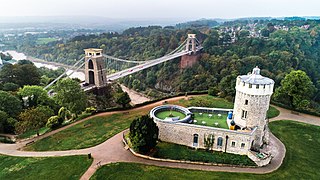
Clifton Observatory is a former mill, now used as an observatory, located on Clifton Down, close to the Clifton Suspension Bridge, Bristol, England.

The Underfall Yard is a historic boatyard on Spike Island serving Bristol Harbour in England.

A Fairbairn crane is a type of crane of an 'improved design', patented in 1850 by Sir William Fairbairn. There are numerous hand-powered versions around the world and one surviving steam-powered example in Bristol Docks, England.
Mill Lane Mill is a Grade II listed tower mill at Carbrooke, Norfolk, England which has been conserved with some machinery remaining.
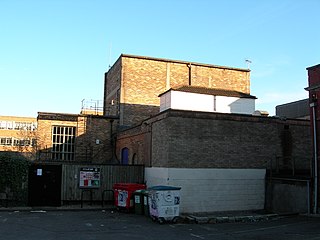
The Cube Microplex is cinema and event venue in Bristol, England. It operates as a non-profit cooperative and is entirely staffed by volunteers. Since opening in 1998 it has hosted international and local artistic and cultural events including films and music performances as well as providing a focal point for Bristol's artistic community. The building includes a roughly 108 seat auditorium as well as a bar serving local and ethical products.

The Garden Village is an area of model village housing built in the early 1900s, in the Summergangs area of Kingston upon Hull, England, for the workers of Reckitt & Sons.
Crucible Industries, commonly known as Crucible, is an American company which develops and manufactures specialty steels, and is the sole producer of Crucible Particle Metallurgy (CPM) steels. The company produces high speed, stainless and tool steels for the automotive, cutlery, aerospace, and machine tool industries.

Temple Quay is an area of mixed-use development in central Bristol, England. The project was initiated by Bristol Development Corporation in 1989, under the name Quay Point until 1995. In that year it was handed over to English Partnerships, under whom development eventually started in 1998. It is bounded by Temple Way to the west and Bristol Temple Meads railway station to the southeast; to the northeast the development was bounded by Bristol Floating Harbour until 2002, when development of Temple Quay North started on the harbour's other side. In 2012 the whole area became part of Bristol Temple Quarter Enterprise Zone.
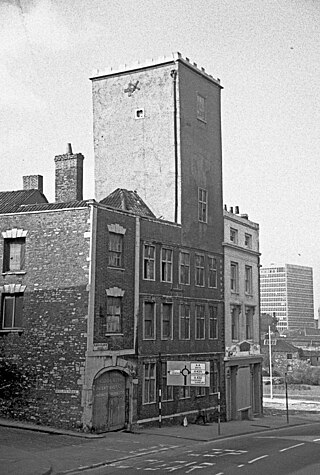
The Redcliffe Shot Tower was a historic shot tower in the English city of Bristol. It was the progenitor of many similar towers built around the world. The tower stood at the corner of Redcliffe Hill and Redcliffe Parade, in the suburb of Redcliffe, between the years of 1782 and 1968.


